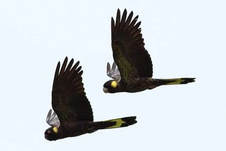 Yellow-tailed black cockatoos. Photo: Wayne Butterworth
Yellow-tailed black cockatoos. Photo: Wayne Butterworth Galahs, ibises, ravens and black cockatoos were once rare visitors to Bass Coast. Nola Thorpe charts the changing face of our birdlife.
By Nola Thorpe
OVER the years I’ve been interested in birds (most of my life) I’ve noticed how the species of birds I’ve been watching have changed.
As a child on a farm at Korumburra South, I never saw galahs, ibis or wattlebirds. And it wasn't until my grandparents moved to Inverloch that wattlebirds appeared on the scene.
We had relatives in Bairnsdale and I would become highly excited at the thought of driving up the highway to get there as we would be sure to see galahs and cockatoos along the way.
We had herons and ducks on our dams but never spotted an ibis.
Galahs now live in Wonthaggi and number in the hundreds. Lorikeets are common and there are wattlebirds everywhere. Noisy miners are now moving into town and myna birds are everywhere (taking over native birds’ nesting sites).
The last couple of years has also seen the arrival of large flocks of litttle corellas which love to swoop and screech in competition with the galahs. We have ravens in the town area and often at dusk they can be seen gathering on the roofs of some of the bigger buildings in the CBD.
Why is this so, I wonder? Is it because of climate change or the trees that have been planted, or is it because human population has spread?
My favourite birds that have come to visit are the yellow-tailed black cockatoos. It’s not unusual to have flocks of 50 or more winging and screeching their way overhead.
My favourite cocky experience took place during the winter following the Black Saturday fires. Terri and I had gone for our early morning walk up to the Rifle Range and right up to the old butts. It was a beautiful, cool, still winter morning The moon was sinking in the west, the sun was rising in the east and about 30 black cockies were wheeling overhead.
An experience I will never forget.
COMMENTS
October 12, 2015
An interesting observation by Nola Thorpe. Who would have thought that Ibis and Ravens were once thin on the ground (and in the air) in Bass Coast country not so long ago.
We lived on our Jeetho West block for a good five years before I saw the first house sparrow. Now the word has got out that we have chooks they are no longer visitors but residents. A friend from Fremantle stayed with us not so long ago and had never seen a sparrow before. She could not have been more delighted than if she had spotted a orange-bellied parrot.
Speaking of which, we had our first king parrot last week taking our backyard species tally to 53. No doubt someone as observant as Nola would have identified many more.
Bob Middleton, Jeetho West
OVER the years I’ve been interested in birds (most of my life) I’ve noticed how the species of birds I’ve been watching have changed.
As a child on a farm at Korumburra South, I never saw galahs, ibis or wattlebirds. And it wasn't until my grandparents moved to Inverloch that wattlebirds appeared on the scene.
We had relatives in Bairnsdale and I would become highly excited at the thought of driving up the highway to get there as we would be sure to see galahs and cockatoos along the way.
We had herons and ducks on our dams but never spotted an ibis.
Galahs now live in Wonthaggi and number in the hundreds. Lorikeets are common and there are wattlebirds everywhere. Noisy miners are now moving into town and myna birds are everywhere (taking over native birds’ nesting sites).
The last couple of years has also seen the arrival of large flocks of litttle corellas which love to swoop and screech in competition with the galahs. We have ravens in the town area and often at dusk they can be seen gathering on the roofs of some of the bigger buildings in the CBD.
Why is this so, I wonder? Is it because of climate change or the trees that have been planted, or is it because human population has spread?
My favourite birds that have come to visit are the yellow-tailed black cockatoos. It’s not unusual to have flocks of 50 or more winging and screeching their way overhead.
My favourite cocky experience took place during the winter following the Black Saturday fires. Terri and I had gone for our early morning walk up to the Rifle Range and right up to the old butts. It was a beautiful, cool, still winter morning The moon was sinking in the west, the sun was rising in the east and about 30 black cockies were wheeling overhead.
An experience I will never forget.
COMMENTS
October 12, 2015
An interesting observation by Nola Thorpe. Who would have thought that Ibis and Ravens were once thin on the ground (and in the air) in Bass Coast country not so long ago.
We lived on our Jeetho West block for a good five years before I saw the first house sparrow. Now the word has got out that we have chooks they are no longer visitors but residents. A friend from Fremantle stayed with us not so long ago and had never seen a sparrow before. She could not have been more delighted than if she had spotted a orange-bellied parrot.
Speaking of which, we had our first king parrot last week taking our backyard species tally to 53. No doubt someone as observant as Nola would have identified many more.
Bob Middleton, Jeetho West